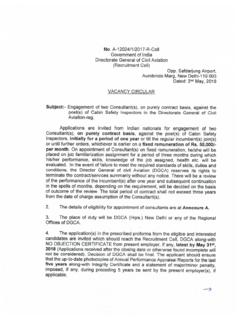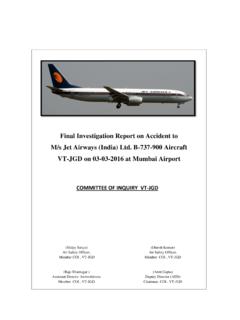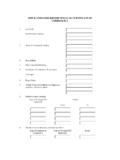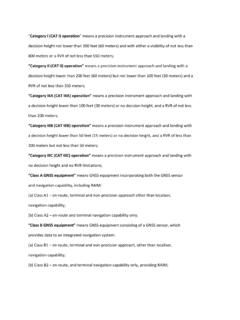Transcription of GOVERNMENT OF INDIA CIVIL AVIATION …
1 1 GOVERNMENT OF INDIA OFFICE OF THE DIRECTOR GENERAL OF CIVIL AVIATION OPP. SAFDARJUNG AIRPORT, NEW DELHI 110 003 CIVIL AVIATION REQUIREMENT SECTION 8 - AIRCRAFT OPERATIONS SERIES C PART I Issue I, Dated 13th June 2011 Effective (Rev 10): 01st April 2017 F. No 22024/6/2012-FSD Subject: All Weather Operations (AWO) 1. INTRODUCTION Aerodrome Operating Minima are established in order to ensure the desired level of safety in Aeroplane Operations at an Aerodrome by limiting these operations in specified weather conditions. The values of aerodrome operating minima for a particular operation must ensure that at all times the combination of information available from external sources and the aeroplane instruments and equipment is sufficient to enable the aeroplane to be operated along the desired flight path.
2 2. APPLICABILITY This CIVIL AVIATION Requirement (CAR) lays down the requirements for all weather operations conducted by Scheduled, Non-scheduled and General AVIATION operators (Aeroplanes). This CAR is issued under the provisions of Schedule II, Rule 29C and Rule 133A of the Aircraft Rules, 1937. 3. DEFINITIONS/TERMINOLOGY For the purpose of this CAR, definitions and terminology associated with AWO are amplified below; Aerodrome operating minima. The limits of usability of an aerodrome for: a) take-off, expressed in terms of runway visual range and / or visibility and, if necessary, cloud conditions; b) landing in 2 D i n s t r u m e n t approach operations, expressed in terms Rev 10, 23rd March 2017 SECTION 8 13TH JUNE 2011 CIVIL AVIATION REQUIREMENTS SERIES C PART I 2 of visibility and/or runway visual range; minimum descent altitude/height (MDA/H) and, if necessary, cloud conditions; and c) landing in 3D instrument approach operations, expressed in terms of visibility and/or runway visual range and decision altitude/height(DA/H) appropriate to the type and/or category of the operation.
3 Alert height. An alert height is a height above the runway threshold based on the characteristics of the aeroplane and its fail operational landing system, above which a Category III operation would be discontinued and a missed approach initiated if a failure occurred in one of the redundant parts of the landing system, or in the relevant ground equipment. All weather operations. Any surface movement, take-off, departure, approach or landing operations in conditions where visual reference is limited by weather conditions. Alternate aerodrome. An aerodrome to which an aircraft may proceed when it becomes either impossible or inadvisable to proceed to or to land at the aerodrome of intended landing where the necessary services and facilities are available, where aircraft performance requirements can be met and which is operational at the expected time of use.
4 Alternate aerodromes include the following: Take-off alternate. An alternate aerodrome at which an aircraft would be able to land should this become necessary shortly after take-off and it is not possible to use the aerodrome of departure. En-route alternate. An alternate aerodrome at which an aircraft would be able to land in the event that a diversion becomes necessary while en-route. Destination alternate. An alternate aerodrome at which an aircraft would be able to land should it become either impossible or inadvisable to land at the aerodrome of intended landing. Note: The aerodrome from which a flight departs may also be an en- route or a destination alternate aerodrome for that flight . Rev 7, 11th July 2015 SECTION 8 13TH JUNE 2011 CIVIL AVIATION REQUIREMENTS SERIES C PART I 3 Approach ban point.
5 The point on a final approach where the reported weather conditions at the runway must meet the applicable minima so as to be able to meet regulatory requirements for continuing an instrument approach to a landing. Automatic flight control system (AFCS) with coupled approach mode. Airborne system which provides automatic control of the flight path of the aeroplane during approach. Automatic landing system. The airborne system which provides automatic control of the aeroplane during the approach and landing. Categories of aeroplanes. The following five categories of typical aeroplanes have been established based the indicated airspeed at threshold (Vat) which is equal to the stall speed Vso multiplied by or stall speed Vs1g multiplied by (whichever is higher) in the landing configuration at maximum certificated landing mass.
6 Category A less than 169 km/h (91 kt) IAS Category B 169 km/h (91 kt) or more but less than 224 km/h (121 kt) IAS Category C 224 km/h (121 kt) or more but less than 261 km/h (141 kt) IAS Category D 261 km/h (141 kt) or more but less than 307 km/h (166 kt) IAS Category E 307 km/h (166 kt) or more but less than 391 km/h (211 kt) IAS Ceiling. The height above the ground or water of the base of the lowest layer of cloud below 6000 m (20 000 ft) covering more than half the sky. Circling approach. An extension of an instrument approach procedure which provides for visual circling of the aerodrome prior to landing. Commercial air transport operation. An aircraft operation involving the transport of passengers, cargo or mail for remuneration or hire. Continuous Descent Final Approach (CDFA).
7 A technique, consistent with stabilized approach procedures, for flying the final approach segment of a non- precision instrument approach procedure as a continuous descent, without level-off, from an altitude/height at or above the final approach fix altitude/height to a point approximately 15 m (50 ft) above the landing runway threshold or the point where the flare maneuver should begin for the type of aircraft flown. Rev 4, 10th December 2013 SECTION 8 13TH JUNE 2011 CIVIL AVIATION REQUIREMENTS SERIES C PART I 4 Converted Meteorological Visibility (CMV). A value equivalent to an RVR which is derived from the reported meteorological visibility, as converted in accordance with the specified requirements in the CAR Decision altitude (DA) or decision height (DH).
8 A specified altitude or height in a 3D instrument approach operation at which a missed approach must be initiated if the required visual reference to continue the approach has not been established. Note 1. Decision altitude (DA) is referenced to mean sea level and decision height (DH) is referenced to the threshold elevation. Note 2. The required visual reference means that section of the visual aids or of the approach area which should have been in view for sufficient time for the pilot to have made an assessment of the aircraft position and rate of change of position, in relation to the desired flight path. In Category III operations with a decision height the required visual reference is that specified for the particular procedure and operation. Note 3. For convenience where both expressions are used they may be written in the form decision altitude/height and abbreviated DA/H.
9 Enhanced vision system (EVS). A system to display electronic real-time images of the external scene achieved through the use of image sensors. Equivalent position. A position that can be established by means of a DME distance, a suitably located NDB or VOR, SRE or PAR fix or any other suitable fix between three and five miles from threshold that independently establishes the position of the aeroplane. Fail-operational automatic landing system. An automatic landing system is fail- operational if, in the event of a failure, the approach, flare and landing can be completed by the remaining part of the automatic system. Fail-operational hybrid landing system. A system which consists of two or more independent landing systems. In the event of failure of one system, guidance or control is provided by the remaining system(s) to permit completion of the landing.
10 Note. A fail-operational hybrid landing system may consist of a fail-passive automatic landing system with a monitored head-up display which provides guidance to enable the pilot to complete the landing manually after failure of the automatic landing system. Fail-passive automatic landing system. An automatic landing system is fail- passive if, in the event of a failure, there is no significant deviation of aeroplane trim, flight path or attitude but the landing will not be completed automatically. Rev 7, 11th July 2015 SECTION 8 13TH JUNE 2011 CIVIL AVIATION REQUIREMENTS SERIES C PART I 5 Final approach. That part of an instrument approach procedure which commences at the specified final approach fix or point, or where such a fix or point is not specified, a) at the end of the last procedure turn, base turn or inbound turn of a racetrack procedure, if specified; or b) At the point of interception of the last track specified in the approach procedure; and ends at a point in the vicinity of an aerodrome from which: 1) A landing can be made; or 2) A missed approach procedure is initiated.












